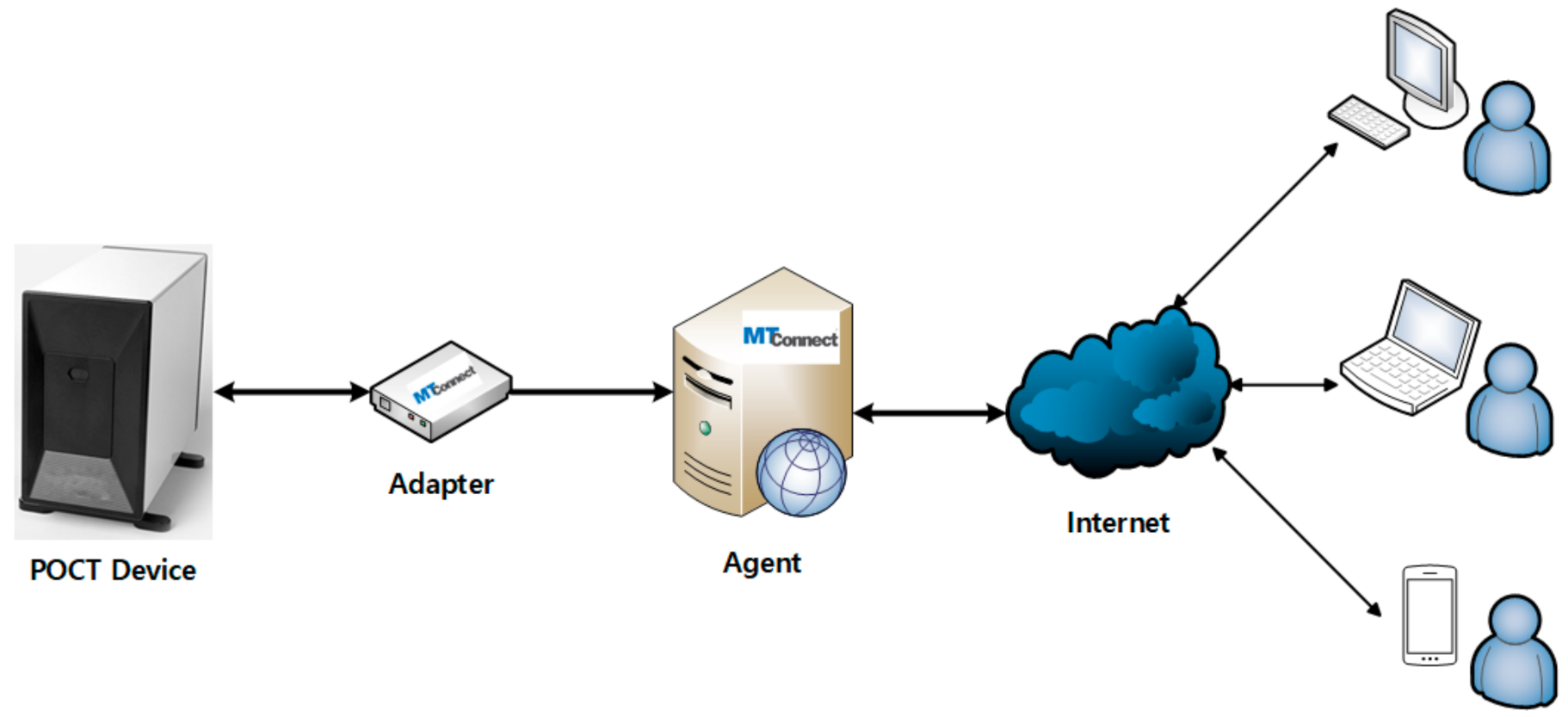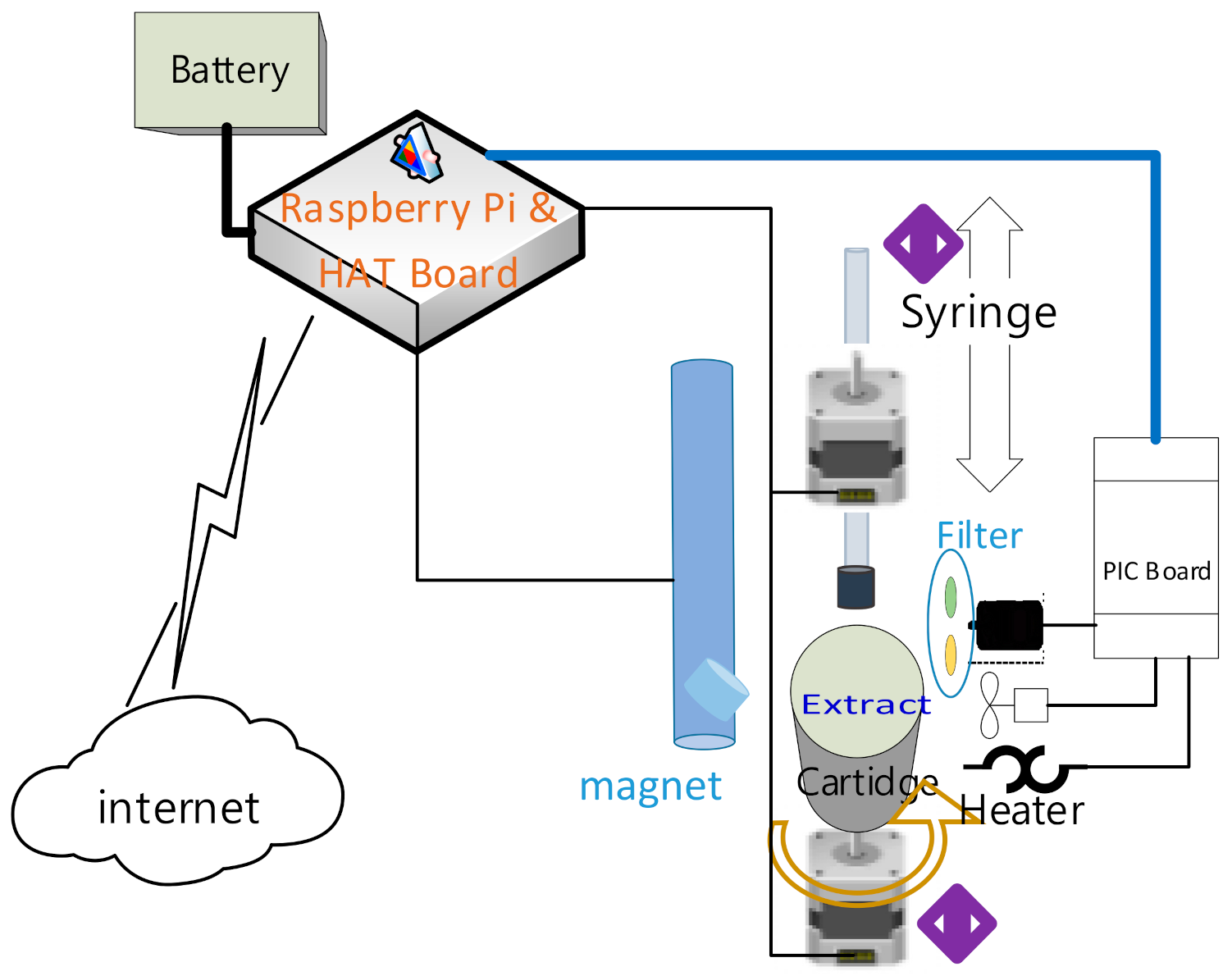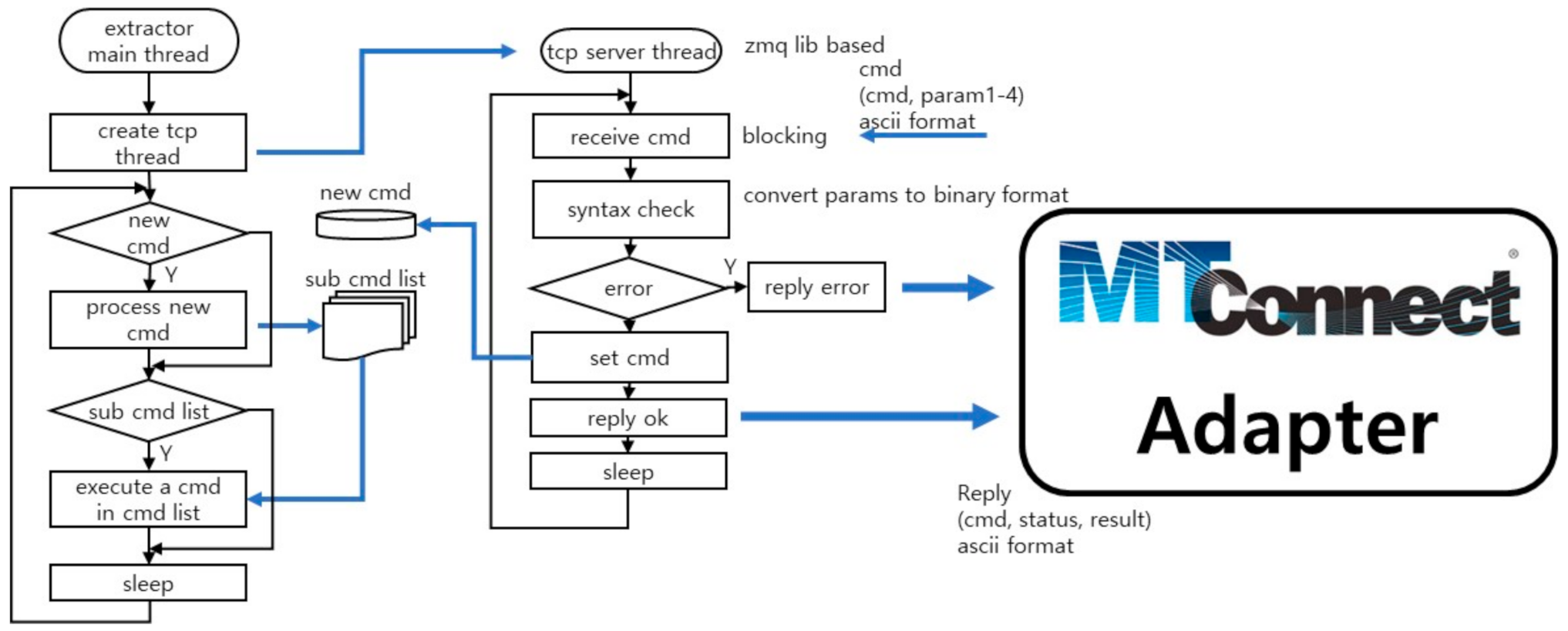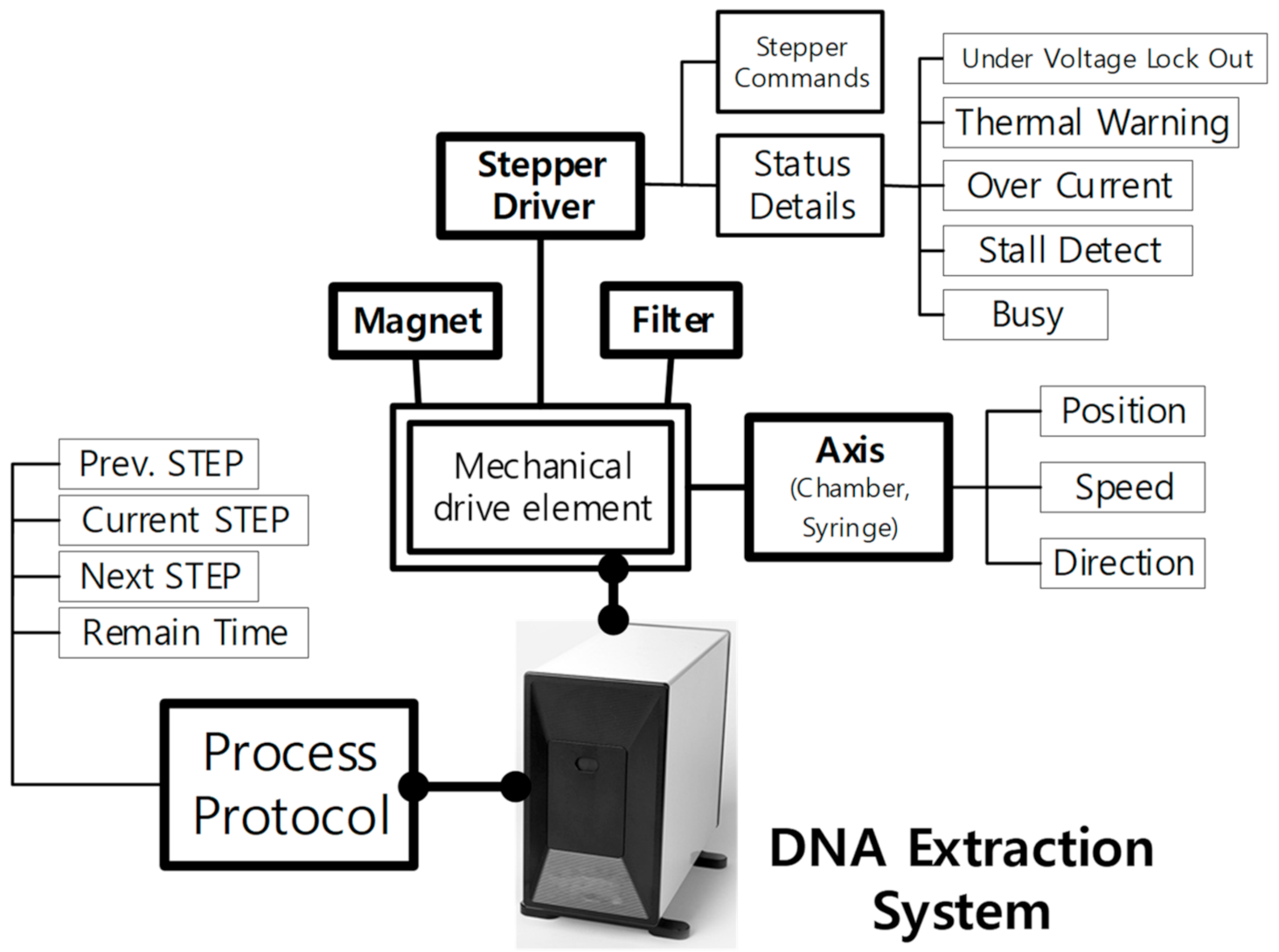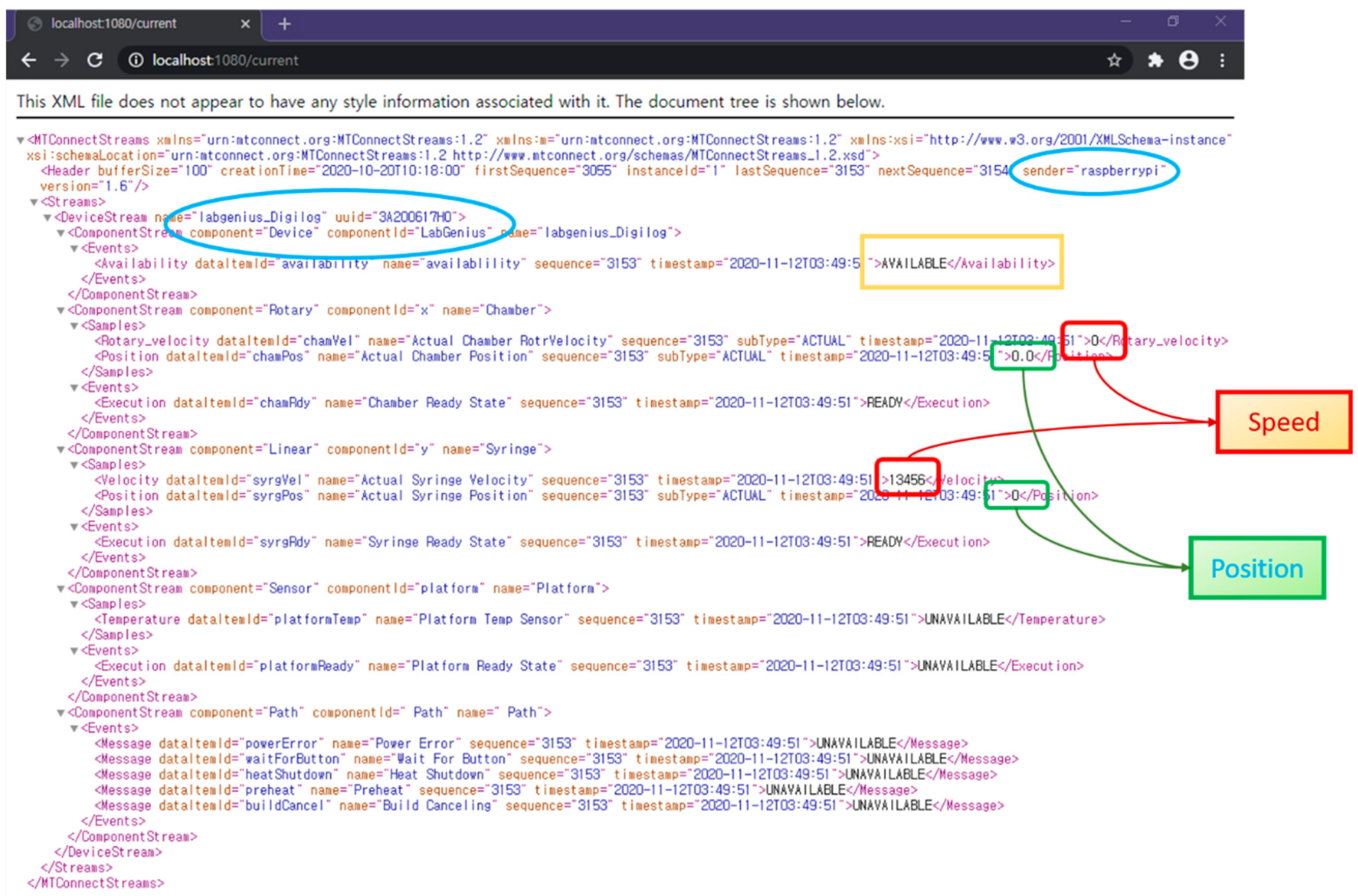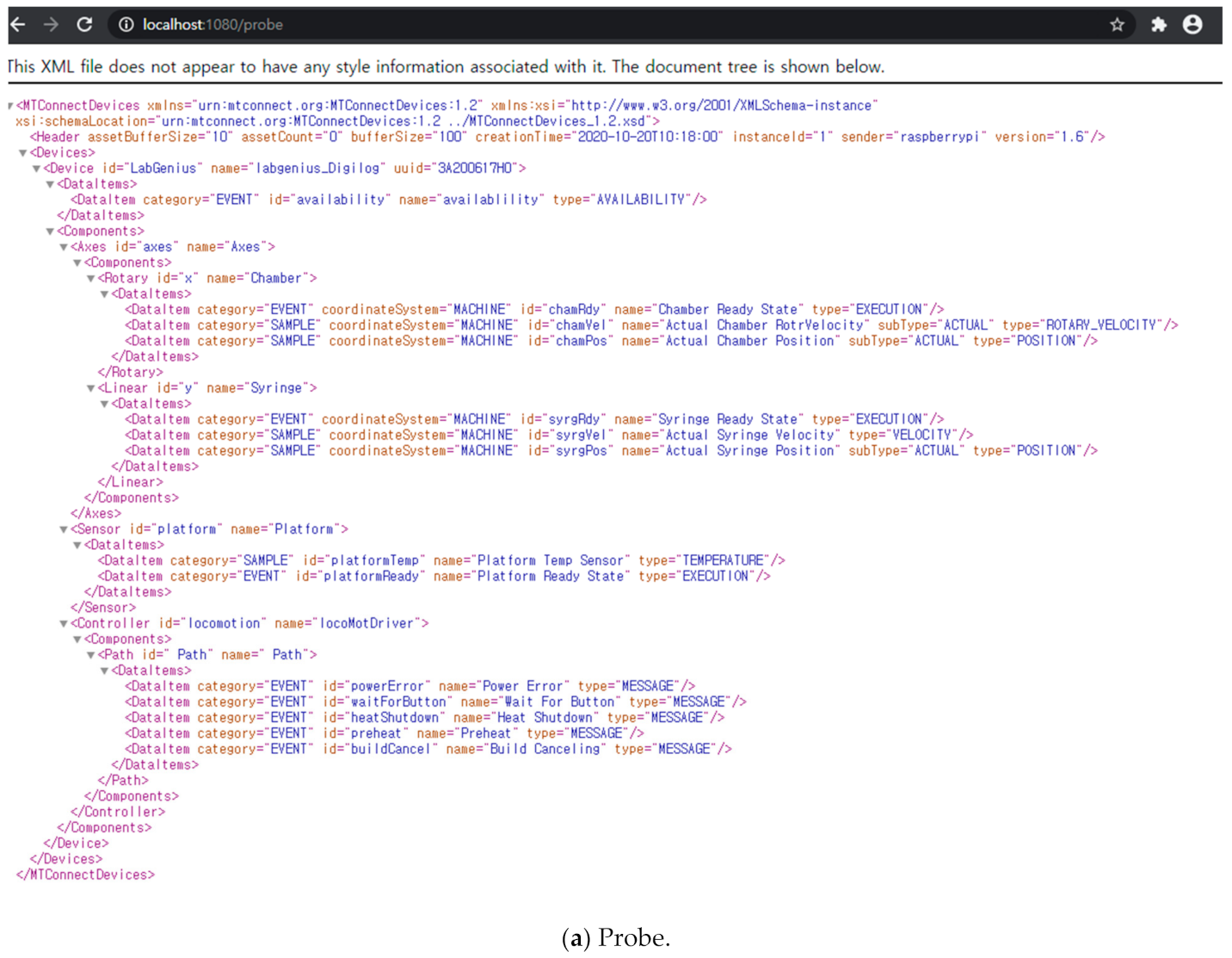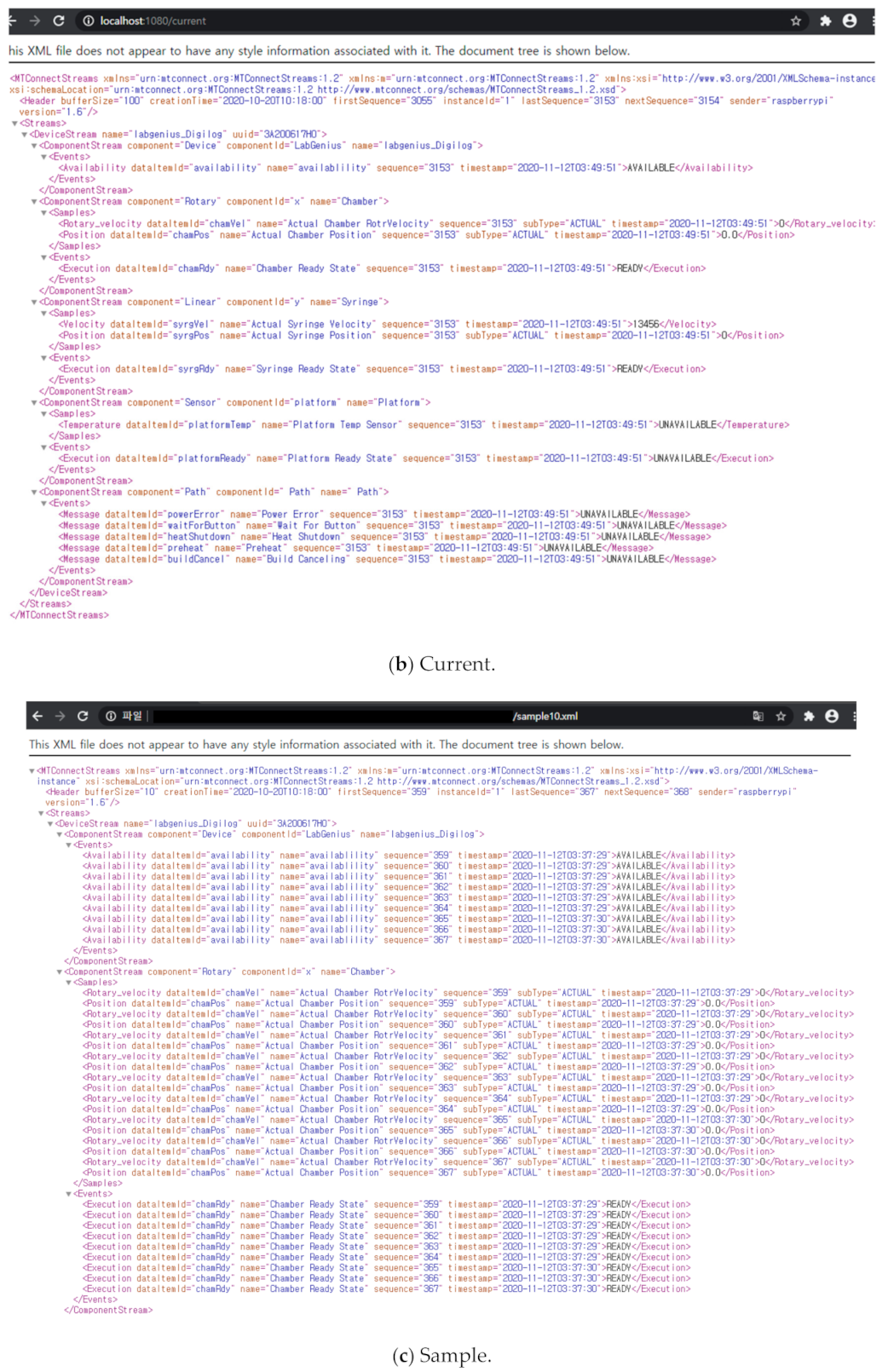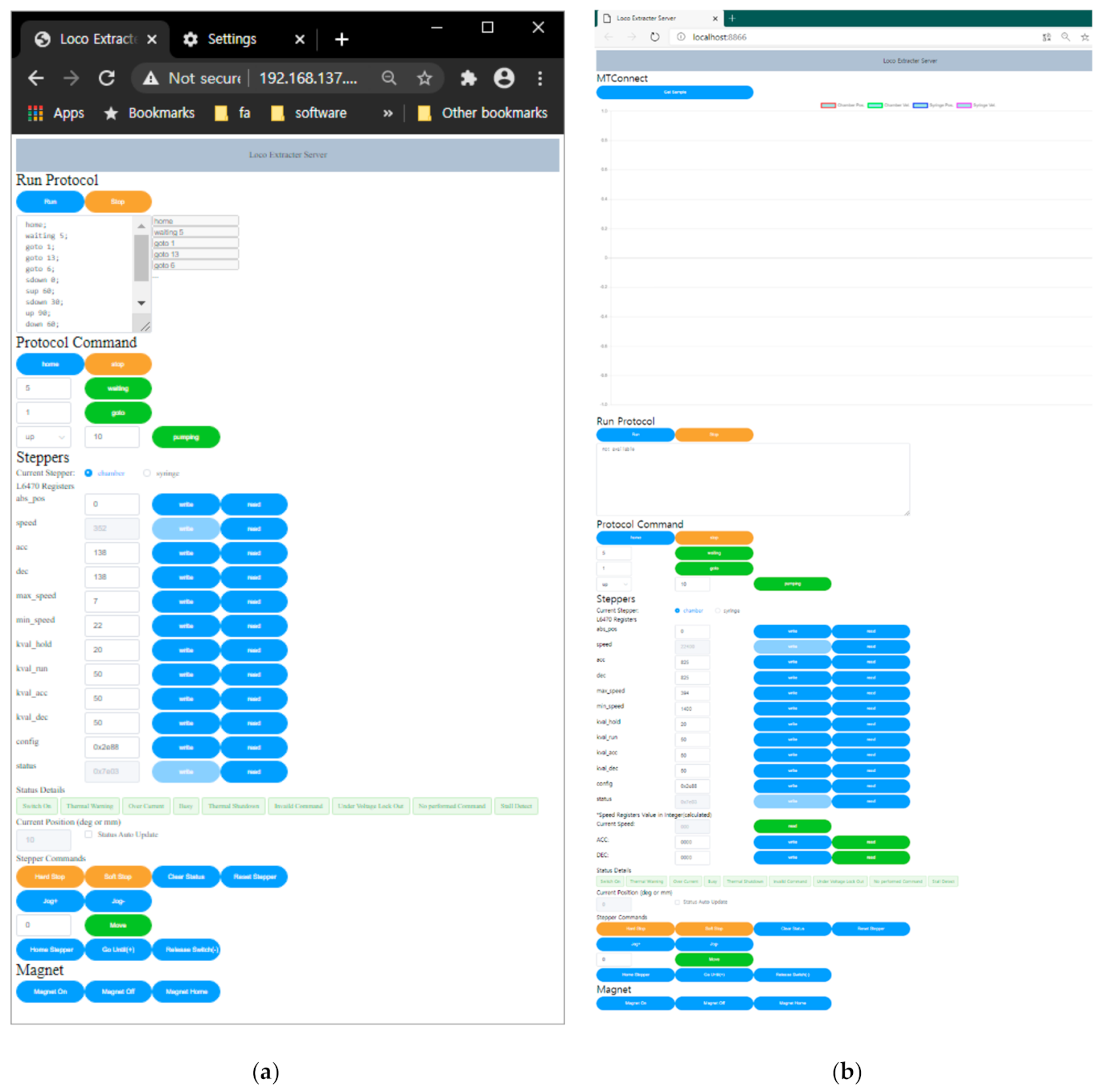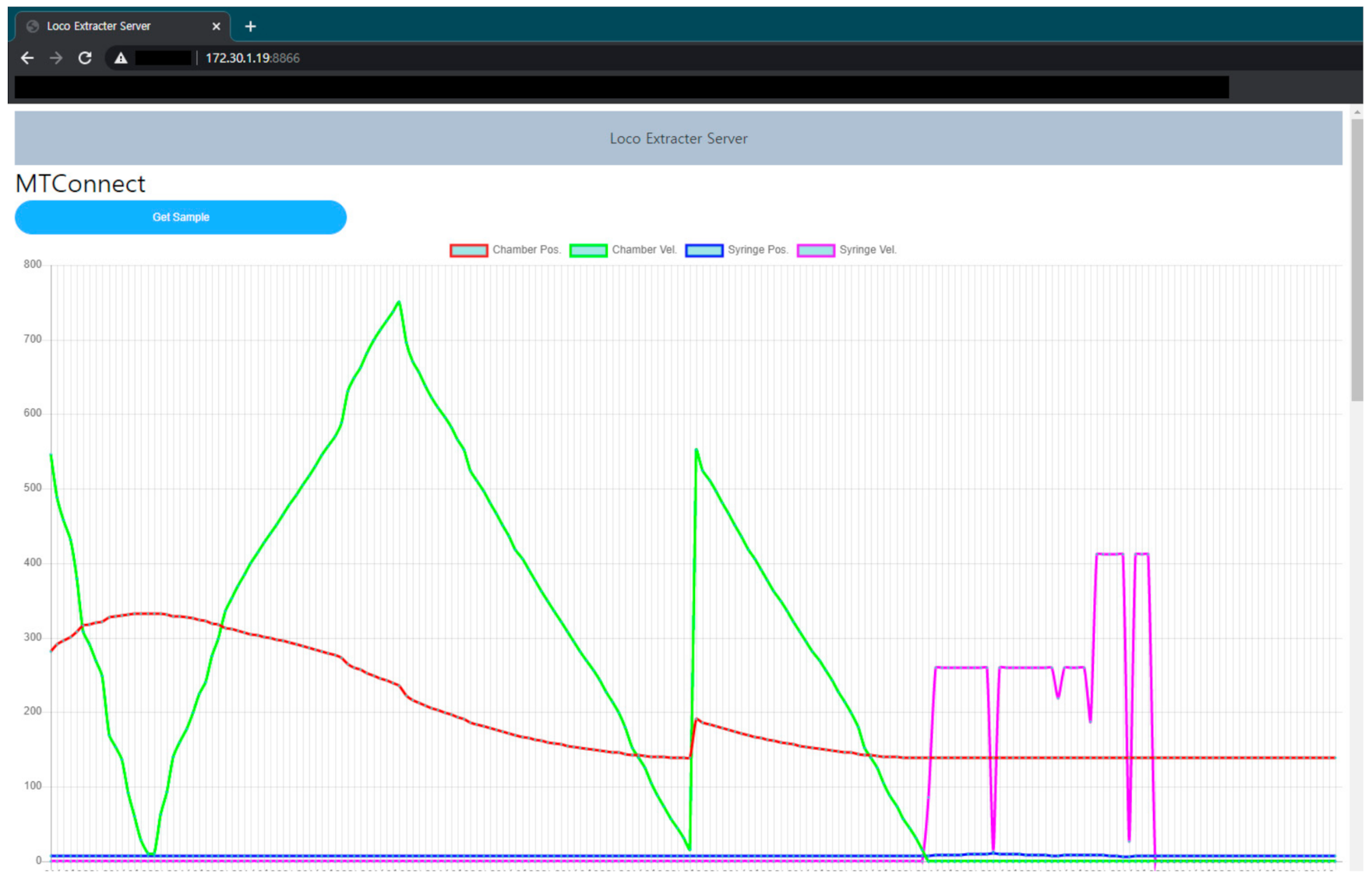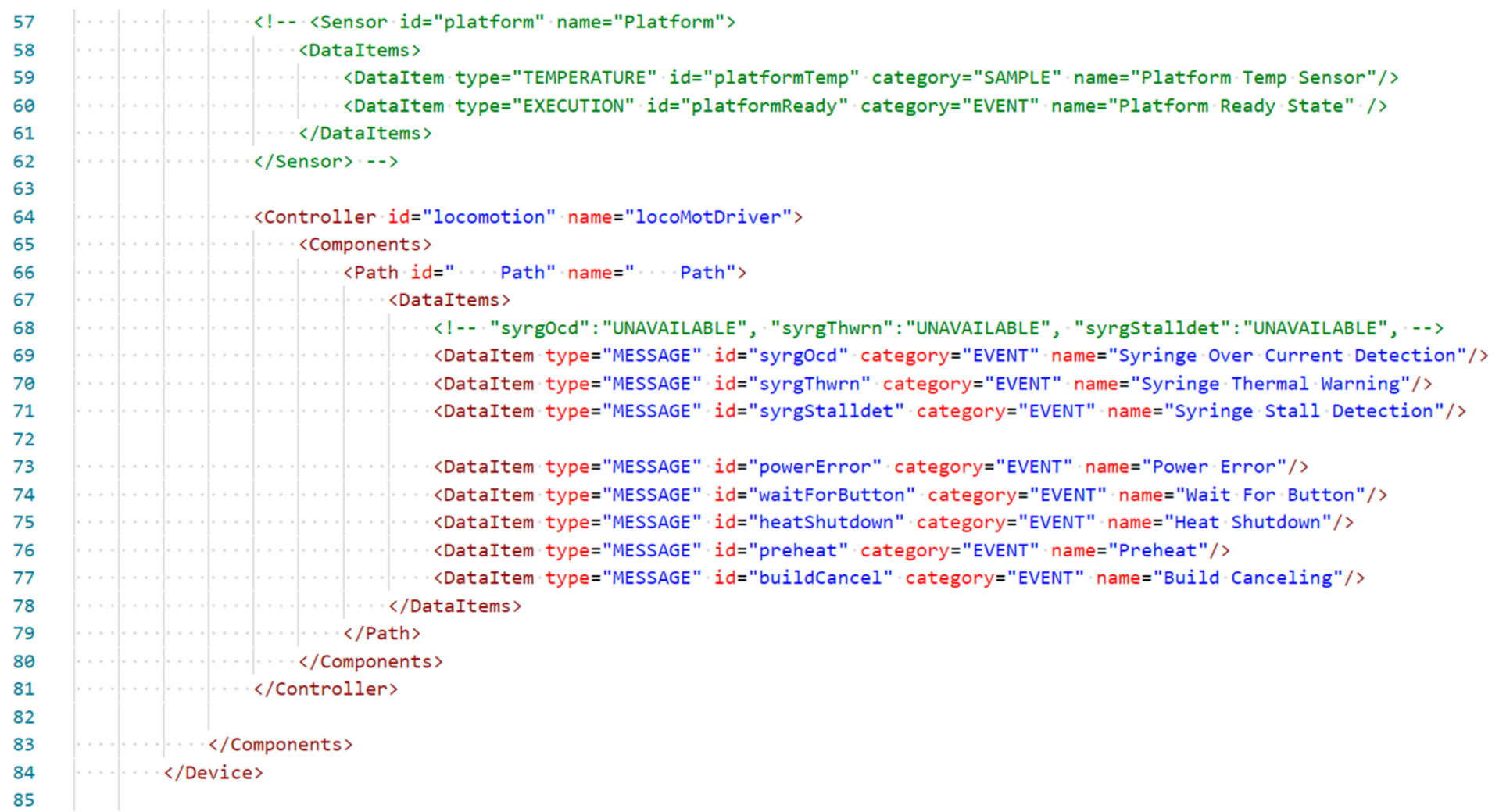1. Introduction
At the core of the smart factory, according to the Industry 4.0 trend, is a technology that enables connection between devices [
1,
2]. MTConnect standard technology provides simplicity, flexibility, and scalability in integrating various equipment and operating systems and enabling accurate and consistent data collection from any MTConnect-compatible system. It can be used to collect and analyze a large amount of equipment data and monitor them over a network. Using MTConnect technology, it is possible to immediately identify the cause of a problem and respond quickly when a problem occurs. For this purpose, it is necessary to monitor the status of equipment and send status information to the manager in the event of a problem.
Since 2007, with the support of the Association for Manufacturing Technology, U.C. Berkeley has been developing a standard protocol and integration method for information exchange between various pieces of production equipment, and as a result, MTConnect was proposed. With this revision and supplementation, MTConnect was established as an open standard based on Transmission Control Protocol/ Internet Protocol (TCP/IP) by the MTConnect Institute [
3]. This makes it possible to access the status information and data on different facilities produced by various manufacturers in a standardized form outside the device. The MTConnect standard enables the implementation of a device-independent and highly scalable monitoring system because detailed information on the equipment requiring the monitoring system can be obtained in Extensible Markup Language (XML) format. As is well known, robots are embedded with sensors to allow for machine–robot or human–robot collaboration in a safe workspace of smart factories. MTConnect standard technology is applicable in the integration of components of smart factories, such as machines and robots [
4,
5,
6,
7,
8,
9]. As a result, more than 500 organizations, including major US and Japanese companies, currently support the standard.
In recent years, the healthcare market has demanded rapid diagnosis and treatment according to diagnosis results, and the types of diagnostic devices suitable for meeting these needs are increasing. Point-of-care testing (POCT) devices have attracted attention in recent years because they enable rapid disease diagnosis. In the field of on-site diagnosis, the trend is to expand to other inspection items by developing technology that prevents errors even when generalists rather than specialists are involved. This also applies to situations that require quick inspection results.
World-class manufacturers in the field of diagnostic laboratory testing equipment have released many field-testing products to meet these needs. Some manufacturers and startups are investing more in POCT field inspection equipment development than in traditional inspection fields. The next-generation molecular diagnosis field is seeing improvements in the accuracy and efficiency of diagnosis based on digital PCR technology. In the field of field diagnosis equipment, microelectromechanical systems (MEMS)and nanotechnology have been applied to miniaturization, and efforts are being made to effectively apply these technologies to the diagnosis and prevention of diseases through the control, inspection, and data management of diagnosis equipment through convergence with IT technology. This trend may be a result of the various advantages of POCT (e.g., shortening of examination times, patient satisfaction, shortened hospitalization times, improved visibility, reduced expenses, and improved preparedness for emergencies) [
10,
11,
12,
13].
POCT equipment has been linked to the telemedicine system, which allows patients to communicate with doctors from their homes. This is a major transformation of the clinical pathological examination system. Confidence in the reliability of POCT equipment is crucial to the equipment’s effectiveness in telemedicine systems. POCT devices must be remotely controlled by a connection to the examination information systems of the medical institution, and the results must be collected, reviewed for quality control purposes, and automatically entered into the patient’s electronic medical record. Therefore, it is a very important to ensure the reliability of diagnosis results for a medical institution to be able to remotely monitor the state of POCT equipment at a remote location in real time. There have been few studies on the remote monitoring of medical devices, including POCT equipment [
14,
15]. However, these medical device monitoring systems simply monitor the measurement results or simple operation status. Therefore, this study proposes a system that can monitor detailed elements of device components with MTConnect standard technology.
In this paper, an MTConnect technology-based monitoring system for automated molecular genetic diagnostic test devices is presented. This automated DNA extraction system consists of a component for gene extraction and gene amplification based on real-time PCR and a Raspberry Pi-based control system that controls a series of extraction procedures. The user can control the system using a web application-based user control interface. In addition, MTConnect, which is an open and standard machine monitoring data interface based on XML [
16], was used to enable POCT device monitoring data collection and monitoring of POCT devices as web application-based clients.
This paper is organized into five sections. The method for system design, automated DNA extraction system, and MTConnect is in
Section 2. The experimental results are in
Section 3, and discussions are reported in
Section 4, and finally, the conclusion is presented in
Section 5.
2. Materials and Methods
The proposed system consists of an automated DNA extraction system, an MTConnect adapter based on the MTConnect standard technology, an MTConnect agent, and a user-controlled UI client application based on a web application.
Figure 1 shows the working principle of MTConnect with the POCT device.
2.1. Automated DNA Extraction System
A molecular genetic diagnostic POCT device is under development by the authors. The system consists of a gene extraction process and a real-time PCR-based gene amplification process. An automated DNA extraction system configuration diagram is shown in
Figure 2.
The DNA extraction mechanism consists of a cartridge with chambers, syringes, four linear stepper actuators, and a rotary stepper actuator. The actuators provide a sequence of steps in the DNA extraction process, including transporting, mixing, and washing to obtain a gene specimen, magnetic bead, and reagent solution. A control application programmed in Python compiles the DNA extraction sequence protocol into binary instructions, triggers the execution of instructions on a controller implemented in Raspberry Pi 3B, and displays the execution status.
The Raspberry Pi-based control system interfaces with the web application-based user control UI through TCP/IP communication and executes protocol sequence commands triggered by the web application-based user control UI. With respect to the axis operation command, the stepper motor controller produces an add-on board in the form of a HAT board that applies the L6470 Stepper Driver IC and connects it to the Raspberry Pi 3B. The L6470 Stepper Driver IC (STMicroelectronics Inc., Geneva, Switzerland) provides smooth linear acceleration and velocity profiles for stepper motor drivers. To establish the mechanical position, the controller provides a homing function that executes an axis motion until coming into contact with a home switch and sets that position as the predefined position. The controller also provides safety checks, such as positive and negative limit checking functions, by which it prevents any axis motion beyond the positions governed by the limit switches [
17].
To evaluate the miniaturization of the automated DNA extraction monitoring system and the usability for portable operation, a system power supply for a portable battery power HAT board was added, along with other component control and function expansion boards, to ensure flexibility in the system hardware configuration.
The system was implemented as a web server with Flask, and a web application-based user control UI was constructed using Vue. JS was used for two-way JavaScript Object Notation (JSON) communication with the motor drive system control driver through ZeroMQ (ZMQ) and to run the automated DNA extraction system. HTTP communication between the web application client and the web server was implemented with Axios, an Ajax library that specializes in handling only asynchronous HTTP requests. Because the web application-based user control UI configured as described above is equipped with a fully automatic system function, it is possible to perform molecular genetic diagnostic tests without specialized knowledge about genetic analysis. The automated DNA extraction system block diagram is shown in
Figure 3.
2.2. MTConnect Standard
MTConnect is a lightweight scalable standard protocol that defines the interface between devices and machine tools and information systems or applications to collect and manage manufacturing data [
18]. MTConnect consists of devices, adapters, agents, networks, and client applications. Unlike Open Platform Communications (OPC), MTConnect provides easily scalable protocols and data expression and exchange methods between production equipment and various applications, but it only specifies a one-way communication protocol that flows from a device to an application.
As a software component of MTConnect, there is an agent at the center of communication, and an adapter is implemented for each of the various existing devices or sensors to relay communication between the device and the agent. The agent transmits the status of the device to the monitoring/analysis application program using a standard web protocol and XML. The data in XML delivered by MTConnect for data exchange are defined by three types of standard schemas: a device schema that describes the type and configuration of the equipment, a stream schema that describes the state of the general data during operation of the equipment, and an error schema that provides information about errors or warnings. A system for monitoring multiple devices follows these schemas and MTConnect communication protocols. When a new device is added, the data for the new device are described only within the context of the exchanged XML document data, without overall modification of the system, enabling flexible expansion [
19].
In MTConnect, the client requesting data and the server (or agent) providing data communicate through an HTTP protocol, and the data exchanged over HTTP are in XML format. The main elements of XML defined in MTConnect can be extended by users. The MTConnect agent stores data from manufacturing facilities in memory or storage by first in, first out (FIFO) means, and when a request from a client is received, the agent provides an XML document containing predefined elements as a response to the request. The elements and content contained in the XML document depend on the type of request. The types of requests that the MTConnect client can send to the MTConnect agent are probe, current, and sample requests.
2.3. MTConnect with Automated DNA Extraction System
The MTConnect adapter and agent were developed on a Raspberry Pi single-board computer. The adapter collects and sends information on the state of the extraction process in the MTConnect standard format. The agent publishes the collected data in XML format through the network and monitors them in a web application acting as an MTConnect client.
2.3.1. MTConnect Adapter
The MTConnect adapter consists of a transmission unit and a connection unit that collects status data on the target equipment between the monitored equipment and the MTConnect agent and sends status data whenever the MTConnect agent requests it.
The method is implemented in the form of an MTConnect agent in Python 3.7, with reference to the “Makerbot Agent-Adapter” source in the official github repertoire of the MTConnect Institute [
20]. Upon receiving a request from the MTConnect agent, the MTConnect adapter accesses the application programming interface (API) of the control program of the Automated DNA Extraction System and obtains the current hardware status information received after transmitting the request. Specifically, it connects to a specific address of the automated DNA extraction system control program and a ZeroMQ-based socket on a specific port, sends a request to JSON according to the format specified in the predefined API, receives the resulting message, and parses it. Data are classified and saved by parameter and returned to the MTConnect agent.
Figure 4 is a flow chart showing how the automated DNA extraction system processes the response of the MTConnect adapter in processing the received DNA processing command.
2.3.2. MTConnect Agent
The MTConnect agent collects data from the MTConnect adapter running on the target device (or the computer connected to the device) to be monitored. Whenever the MTConnect client receives a request from a running device, the collected data are processed and provided in XML format according to the request type.
MTConnect can express metric data for use in the operation of an on-machine configuration system. MTConnect documents consist of dynamic data in the form of time series with time stamps. The MTConnect agent generates raw data collected from machine tool controllers and measuring devices, in compliance with the MTConnect protocol. From these MTConnect documents, we collect instances of attribute data that users need. MTConnect documents can be obtained either directly from the MTConnect agent or indirectly from external databases and manufacturing equipment applications.
In the automated DNA extraction system’s web application-based user control UI server program, a dedicated API web socket that transmits requests to and processes responses from the MTConnect agent is added and initialized, and the MTConnect agent resides in memory and starts to operate. When the web app client requests MTConnect data, the web server program sends the relevant request to the agent in JSON format, receives the response data, and then transmits the XML data according to the MTConnect standard format received by the agent to the client that requested the data.
MTConnect is a standard originally developed to interface between information systems or applications with production equipment and machine tools to collect and manage manufacturing data. Many of the general “DataItems” specified in the standard are far from those optimized for the characteristics of medical devices. Therefore, “DataItem,” the specific device component of the automated DNA extraction system to be monitored through MTConnect, was selected as an element suitable for the characteristics of POCT equipment, based on the latest MTConnect Version 1.6 standard specification and implemented in the agent.
Figure 5 is a schematic diagram of the information models of the automated DNA extraction system, organized according to the relationships of major components.
2.4. MTConnect Monitoring Client Web Application
The MTConnect monitoring client receives XML data from an agent that complies with the MTConnect standard, processes it into a format that is easy for users to see, and displays it on the GUI screen of the user device.
Although the MTConnect standard transmits data in XML format, which is a well-organized hierarchical structure, most of the data read from the agent by the MTConnect client is in a structure that is difficult for users to see and understand at a glance.
Figure 6 is an example of an instance of the collection of attribute data related to the position and speed of a specific driving unit from the MTConnect XML document.
The data received by the MTConnect client are extracted using the XML parsing method and then visualized and displayed to the user in real time.
The MTConnect monitoring client application is implemented with elements and structures similar to the web application-based user control UI of the automated DNA extraction system.
Figure 7 is a block diagram showing how the MTConnect data flow in processing the response of the web application command.
3. Results
The MTConnect monitoring client presented in this paper was verified in operation by interworking with the MTConnect agent installed on the Raspberry Pi 3B. The automated DNA extraction system measured the system response speed in the idle state.
3.1. MTConnect Agent and MTConnect Adapter
The MTConnect adapter generates selected elements from the “DataItem” of the automated DNA extraction system’s information model, based on real-time hardware information from the automated DNA extraction system. This allows the MTConnect agent to respond to requests from MTConnect clients. The MTConnect agent works as a structure to prepare for data requests from clients by collecting target system data from the adapter at 100 ms intervals and storing them in a buffer.
There are three types of data that an MTConnect client can request from the MTConnect agent. “Prove” requests device components and data items, “Current” requests data item values or device status information at a specific point in time, and “Sample” requests samples, events, status information, etc. for a specific continuous period. These three types of data form the basis of the MTConnect standard, and they are implemented to respond to client requests correctly and accurately (
Figure 8).
3.2. MTConnect Monitoring Client Application
The MTConnect monitoring client application is located on the same page as the web application-based user control UI (
Figure 9), so that user control feedback can be immediately checked through MTConnect monitoring, enhancing the usefulness of function utilization. In addition, by implementing a web application-based client using Vue.JS, we sought to guarantee the same user experience regardless of the client’s platform and equipment.
When the MTConnect monitoring client application clicks the “Get Sample” button on the UI, it sends a “Sample” request to the MTConnect agent. After receiving the response data, the speed and position elements of each motor drive shaft are extracted using XML Parser. This was implemented to create a chart on a web page using the responsive chart library “vue-charts” (
Figure 10).
When any major error or failure occurs while MTConnect is monitoring the automated DNA extraction system, the MTConnect client web application displays the information on the web application to induce the user to respond appropriately.
Figure 11 shows the major failure factors monitored by the MTConnect agent, and
Figure 12 shows errors such as over current and stall detection. These errors were generated intentionally for demonstration purposes.
3.3. Performance Evaluation
The performance and reliability of the entire system were evaluated by verifying the request response time for each section of the data flow from the web server of the implemented system to the device driver.
Table 1 shows statistics obtained by repeatedly measuring the request response time for each section 1000 times when the automated DNA extraction system is in the idle state.
When the request response time of the measurement target section is measured, the time required to execute the method is saved as a log file, and the data are obtained and analyzed. As a result of reviewing the data obtained after several repeated tests for a long period of time, there was no error in the method execution result or number, so we came to the conclusion that the system described in this study operates very stably.
4. Discussion
POCT is used in various fields, such as medicine, quarantine, agriculture (breeding), and food. In particular, its use in the medical field is very important because it takes a short time from the start of a test to diagnosis and is not restricted by location and time. The reason why this is receiving such attention from the industry is that the patient’s condition changes from moment to moment, and the appropriate response at the beginning is effective for treatment. In addition, the necessity of being able to monitor POCT equipment and manage it remotely is particularly important for the specialty of remote medical treatment.
This study demonstrated the possibility of the remote monitoring of automated diagnosis processes using POCT devices and the MTConnect standard technology, in the field of in vitro diagnostic testing. Previous studies on the MTConnect standard technology were limited in application to equipment monitoring in the manufacturing industry. This study has demonstrated that MTConnect standard technology can be applied to monitoring the status of medical equipment in multiple remote locations in real time.
The average response time of the system implemented in this study was longer (11.39 ms, 9.62 ms, and 10.55 ms for sample, probe, and current commands, respectively) than that of the system described in a previous MTConnect study (4.80 ms, 4.81 ms, and 4.50 ms for sample, probe, and current commands, respectively) [
21]. The reason for the longer response time of this study seems to be that the proposed system handles not only the MTConnect function but also the DNA extraction process. In this study, it was expected that the optimization of each program implemented on a single-board computer and running at the same time was necessary, along with optimization of the interlocking parts.
In a follow-up study, the adaptability and performance of the currently implemented MTConnect monitoring solution to other medical devices must be tested. This will require efforts to improve the performance of the MTConnect system and expand is application to other companies’ equipment in the manufacturing facility industry.
